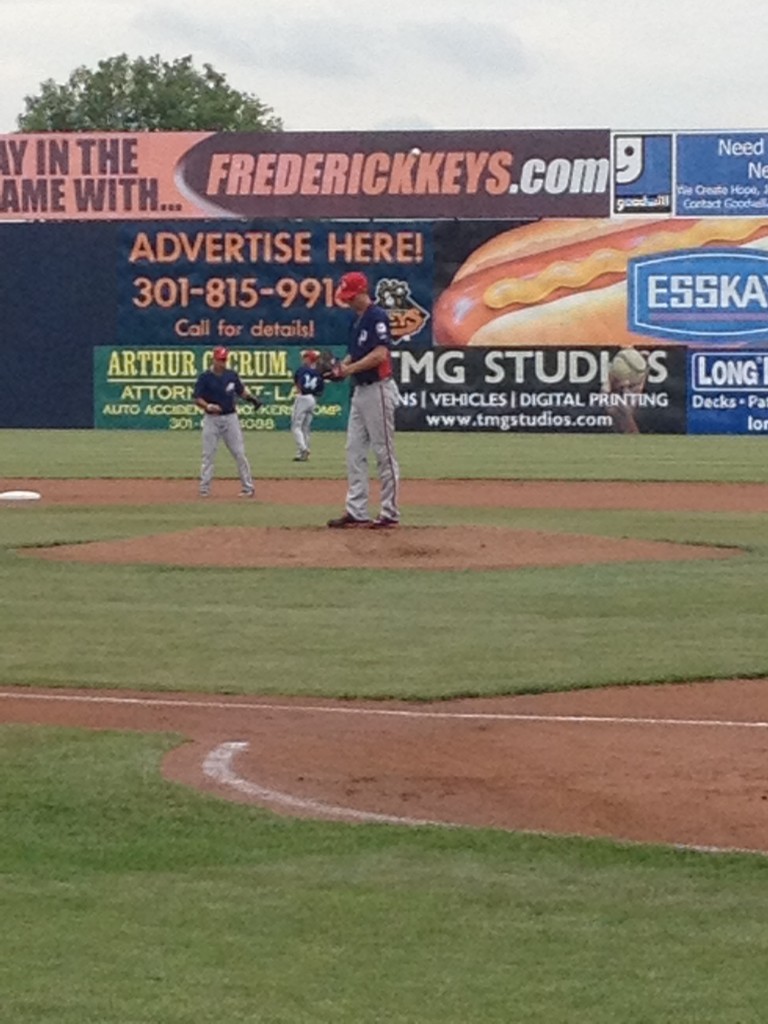Determined to spend the day outdoors enjoying the unusually comfortable August weather, I drove to Hagerstown Sunday to observe the Nationals Low-A minor league affiliate, the Hagerstown Suns, host the Kannapolis Intimidators, the Low-A farm team of the Chicago White Sox.
Municipal Stadium, home of the Suns, is one of the most charming minor league stadiums I have ever experienced, with a manually operated scoreboard in left field, an extensive list of quality food and beer options, and the overall nostalgia of a ballpark built nearly 85 years ago. Always an enjoyable experience, I strongly recommend every baseball fan try to attend a home Hagerstown Suns game.
Sunday was no exception, as I was treated to a well-played game of Low-A baseball and plenty of future major league talent on the field. Here are some of my scouting notes from yesterday’s contest.
Kylin Turnbull LHSP Hagerstown Suns
I was particularly excited to watch Turnbull Sunday afternoon, as he has been a popular name in the Nationals farm system since being selected in the 4th round of the 2011 draft. Now almost 24-years-old and scuffling with a 4.58 ERA in Low-A, I wanted to scout Turnbull and get a better feel for his potential to progress up the organizational ladder.
Immediately one notices Turnbull’s ideal pitchers frame with projection remaining, as he is listed at 6-5 205lbs. and his pitching motion is rather simple and clean without much wasted motion. He hides the ball well as he comes to the plate, though he should try to get better extension as he releases the ball to take advantage of his length. He is also very athletic, especially for his size, as he fields his position well and made a noteworthy diving attempt to catch a bunt in the 6th inning.
Unfortunately Turnbull’s repertoire is not as impressive, as his fastball sat 85-88mph, both from the windup and the stretch with some arm side movement, and he located the fastball fairly well all afternoon. In addition Turnbull featured a below-average 77-80mph slider that needs more late bite to miss bats, and an intriguing, but inconsistent 79-82mph split-finger that had interesting screwball-type movement.
While there is a lot to like about Kylin Turnbull as a prospect, I question his future potential as there are precious few pitchers with velocity below 90mph in the majors unless they have a quirky throwing motion or an elite off-speed pitch. I believe the Nationals should convert Turnbull to the bullpen this fall, as he could add velocity in shorter appearances and his changeup should keep right-handed batters off-balance, making him more than a pure lefty specialist.
Tony Renda 2B Hagerstown Suns
Drafted by the Nationals in the 2nd round last summer, the 22-year-old Renda has performed well in Hagerstown this season, hitting nearly .300 with about the same number of walks as strikeouts. Tony Renda does not have much projection left in his generously listed 5-10 170lbs. frame and he looks small in stature compared to the other players: in fact, a man seated behind me confused him for the bat boy before the game. What Renda does not have in physical size, he makes up for with an excellent ability to make contact with the baseball with lightning-quick wrists, solid hand-eye coordination, and above-average bat speed in a compact swing. Quite simply, Renda can hit.
Renda owns average to slightly above-average speed and athleticism and plays extremely hard, but his mediocre arm strength limits him defensively. Renda is a difficult prospect to label, as his power is negligible and his defense, arm, and speed are just mediocre, yet his special ability to make hard contact as a batter leads me to think he could carve out a career in the major leagues. Renda has little left to prove at Low-A, and I am surprised the Nationals have not promoted him to High-A Potomac.
Tim Anderson SS Kannapolis Intimidators
Drafted 17th overall in the 2013 MLB Draft, Anderson’s sheer talent and impressive athleticism are overwhelmingly obvious and he was clearly the most talented player on the field. Anderson has a lean, wiry frame with potential to fill out, and has above-average to plus speed.
Defensively Anderson possesses a strong, above-average throwing arm, soft hands at shortstop, and solid instincts for the position. On Sunday Anderson was impressive going to his left defensively, and showed off an Olympic athlete-type vertical leap in the 4th inning. With refinement Anderson profiles as an above-average or better defender at shortstop in the major leagues.
Anderson is less developed as a hitter but owns extremely quick wrists and apparent bat speed, but like most 20-year-olds he still struggles to make consistent contact. I was impressed by his approach at the plate, which when combined with a good swing should allow him to hit for average as he moves up the White Sox system. I doubt that he hits for much power, probably chipping in 5-7 homers per season, but I envision him hitting plenty of doubles and triples as a hitter.
An outstanding athlete with baseball instincts, Anderson will need plenty of development time in the minor leagues, but I would bet on this immense talent playing shortstop in the major leagues in a few years.
Others of Note:
Finally Kannapolis’ reliever Euclides Leyer entered in the 8th inning and flashed a quick pitching arm along with a 92-94mph fastball and a low-80s slider with some bite. His fastball is pretty flat and there is little deception in his motion, which allowed the Hagerstown hitters to square him up and likely explains 5.57 ERA in 2013. Only 20-years-old with projection remaining in his slender frame, his weaknesses are obvious, but he has potential if he can refine his command and the mechanics in his delivery. Leyer is definitely a name to remember in the White Sox farm system.




